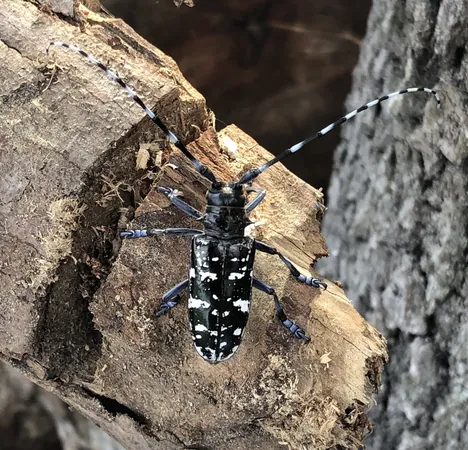
Unleashing Nature's Allies: How Biocontrol Could Be the Key to Combat the Asian Longhorned Beetle
2025-07-02
Author: Olivia
A Destructive Invasion: The Asian Longhorned Beetle Threat
Since its alarming discovery in New York back in 1996, the Asian longhorned beetle (Anoplophora glabripennis) has posed a grievous danger to the rich biodiversity of hardwood trees across the United States. This striking black-and-white pest not only wreaks havoc on tree trunks but also endangers beloved species such as maple, birch, and elm, marking it a formidable foe in American forests.
Innovative Biocontrol: Nature’s Arsenal Against ALB
But could the answer lie in the very nature that the beetles threaten? A groundbreaking review published in June in Environmental Entomology has shed light on an exciting array of microbial antagonists—fungi, bacteria, and nematodes—that could turn the tide in the fight against Asian longhorned beetle infestations. Lead author Ann Hajek, Ph.D., a professor emerita from Cornell University, highlights the significance of this research as a long-overdue examination of these natural biocontrol agents.
Fungal Warfare: The Power of Pathogens
Among the most intriguing of these agents are insect-killing fungi from the Beauveria and Metarhizium families. These miniature assassins latch onto the beetles, infiltrate their bodies, and ultimately lead to their demise. Initial trials have shown that beetles exposed to these fungi have shorter life spans, lay fewer eggs, and can even transmit pathogens to their progeny.
Innovatively, researchers have begun wrapping tree trunks with fungus-coated bands to infect the beetles strategically. Inspired by a commercial product already in use in Japan for similar beetle problems, Hajek and her team adapted this strategy for the ALB. However, the U.S. has largely focused on eradication rather than management, leading to challenges in conducting field trials.
Limitations and Solutions in Research
In collaboration with researchers in China—where the beetle is native—Hajek's team faced various hurdles as the fungi required moisture to be effective, yet many ALB populations were found in arid regions. After dealing with unsuccessful seasons, research in the U.S. pivoted to testing the viability of fungal bands under local conditions, ensuring compliance with environmental regulations.
A Multifaceted Approach to Beetle Management
While fungi target adult beetles, nematodes such as Steinernema carpocapsae and S. feltiae zero in on larvae, delivering swift fatalities. Other contenders in the biocontrol arena include Bacillus thuringiensis (Bt), although its effectiveness is hindered by the larvae’s protective abode deep within trees.
Why Are Biocontrols Not Widely Used?
Despite their promise, these biocontrol measures have not been fully embraced in the U.S. due to the country’s aggressive eradication policies which prioritize the swift removal of infested trees. For now, these microbial solutions serve as contingency plans—powerful yet underutilized tools that could be integral if outbreaks escalate.
Learning from Japan: The Potential for Biocontrol Adoption
Hajek believes the United States could benefit from studying Japan's successful implementation of fungal bands. "When the need arises, I believe the U.S. industry can adopt similar strategies," she asserts.
Citizen Scientists: Essential Allies in the Fight
Hajek’s passionate commitment to battling the beetle remains, even post-retirement. She acknowledges the critical role of citizen scientists, with many ALB infestations first identified by vigilant members of the public. Their contributions have proven indispensable in the ongoing effort to protect America’s trees from this invading menace.
The Future of Biocontrol: Friends in High Places
While fungi, worms, and microbes may not provide instant solutions, they are formidable allies poised to make a significant mark in managing the Asian longhorned beetle's impact. As researchers continue to explore innovative combat strategies, the battle for our forests rolls on—with nature’s hidden warriors preparing to join the fray.









 Brasil (PT)
Brasil (PT)
 Canada (EN)
Canada (EN)
 Chile (ES)
Chile (ES)
 Česko (CS)
Česko (CS)
 대한민국 (KO)
대한민국 (KO)
 España (ES)
España (ES)
 France (FR)
France (FR)
 Hong Kong (EN)
Hong Kong (EN)
 Italia (IT)
Italia (IT)
 日本 (JA)
日本 (JA)
 Magyarország (HU)
Magyarország (HU)
 Norge (NO)
Norge (NO)
 Polska (PL)
Polska (PL)
 Schweiz (DE)
Schweiz (DE)
 Singapore (EN)
Singapore (EN)
 Sverige (SV)
Sverige (SV)
 Suomi (FI)
Suomi (FI)
 Türkiye (TR)
Türkiye (TR)
 الإمارات العربية المتحدة (AR)
الإمارات العربية المتحدة (AR)